Kuala Lumpur
The best places to visit in Kuala Lumpur.
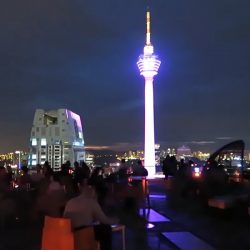
Heli Lounge Bar
What happens to be one of the five operational helipads of the city during the day turns into a thriving rooftop bar once the sun sets. The rooftop bar is accompanied by a lounge downstairs. While the lounge has an aeronautical themed decor, the rooftop bar is furnished with some simple lounge chairs and a portable drink station. With few pegs down, you better watch your steps on this helipad turned bar, as the place does not have any walls or rails to keep you off from falling all the way down the 36 floors if you get too far to the edges.
With checkered flooring, the lounge offers a comfortable ambiance. You will find waiters dressed as pilots serving common selections of cocktails, wines, and spirits. While you will not get any exquisite choice of liquor here at the Heli Lounge Bar, but you certainly do not get chances to raise a toast sitting on a helipad every other day. If you need more reasons to pay a visit to this comparatively inexpensive place, you got the opportunity to see the best sunset from the roof while you take a quick sip on your glass of Lychee Martini.
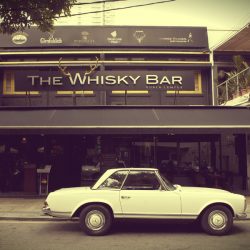
The Whiskey Bar
There are hardly any prizes for guessing the specialty of this favorite bar of locals and expats of Kuala Lumpur. Whiskeys! The place has almost 500 labels of whiskey to offer to its guests. You would not get such a collection of whiskey in the whole of South East Asia, let alone Malaysia. The cozy interiors with the leather round chairs would set up the mood as you order for some of the rarest names from the world of whiskeys.
Take the different whiskey flights that would cost about RM 90-140 and will let you treat your taste buds with some of the finest whiskeys from all around the world. Glen Elgin, Benriach, Aushentoshan, Glenkinchie and what not! If you are an avid whiskey lover, this place will haunt you in your dreams is what we guarantee. If you aren’t, this place will still not turn you down. It offers a wide range of cocktails as well, but all of them will have a subtle taste of whiskey in them.
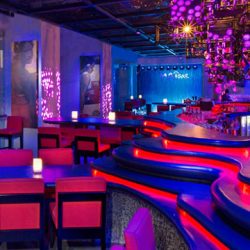
Mai Bar
Love the taste of exquisite cocktails? Enjoy the loud and pulsating music? Looking for a poolside rooftop bar? The Mai bar is the place where you should find yourself at. The bar has the pride of offering some of the widest range of creative concoctions that are not to be found anywhere else in the town. Some of the must try cocktails here at the Mai Bar include the ‘Malaysian Princess Mai tai’ and ‘Mr. Jack’ both of them being the signature cocktail of this amazingly lavish and comforting bar.
The bar is very near to the KL Sentral stop and can be easily reached by means of LRT from KL City Center. The casual furnishing and the neon lights of the place offers an intoxicating experience that gets doubled as you enjoy the delicious cocktail that gets served to you here at the Mai Bar.

Luna Bar
What could be more refreshing than taking a quick dip in the swimming pool of Luna Bar before enjoying their wide range of cocktails? Luna Bar is one of those very few bars that offer a 360º view of the city of Kuala Lumpur with the stunning panorama of the Petronas Twin Towers. The bar is located on the 34th floor of Pacific Regency Hotel Suites and offers the usual selection of wines, beers, and spirits.
It is definitely not one of the inexpensive options of bars here in Kuala Lumpur. However, if you consider the exquisite cocktails, lip smacking taste of homemade sausages and the luscious lamb cutlets coupled with the mesmerizing view of the city, the price of RM50 might not sound a very big one. The bar cum lounge is a favorite for local celebs as well. Do not be surprised if you find the local supermodel matching your steps as you tap your feet to the music of the DJ who play till the shutters are down.
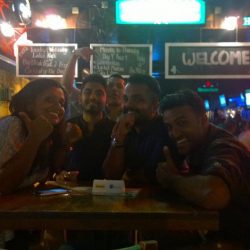
Delaney’s The Irish Pub
Located in Bukit Bintang area of Kuala Lumpur and very near to Low Yat Plaza, Delaney’s Irish Pub lets you savor our taste buds with some Irish liquids and cuisine. The furniture and fittings of the place are being shipped from Dublin and provide the perfect European ambiance in the middle of a busy South Asian country. The place offers the usual range of wines, beers, and spirits. What makes it popular among the European expats is the classic taste of Irish food that gets cooked by chefs who have more than 25 years of experience up their sleeves. Paying a visit here during the afternoon will not only let you relax with a chilled glass of Guinness but will also let you enjoy the benefits of happy hours. The affectionate behavior of the staff is another reason that makes people go back there time and again.
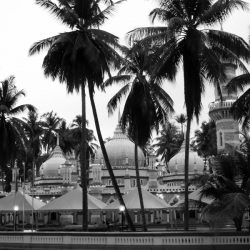
History of Kuala Lumpur
The founding of Kuala Lumpur
Kuala Lumpur is a relatively young city. It is estimated that Kuala Lumpur is established in 1857 as an important site for the tin industry. Around that time it was Raja Abdullah bin Raja Jaafar gave the order to hire tin prospectors and Chinese miners to explore the jungle area of Ampang to find and open new tin mines. After finding tin in the Ampang area, the location of the current Kuala Lumpur became the transshipment point for the tin mines.
It is not known who gave this settlement the name of Kuala Lumpur, which literally means muddy confluence. There are two main theories and several suggestions how the city has got its name. The first main theory states that Kuala Lumpur is named after Sungai Lumpur (muddy river), since Sungai Lumpur was the most important site for the tin industry up the Klang River at that time. The second main theory states that the name of Kuala Lumpur is derived from its location at the confluence of the Klang river and the Gombak river. In Malay the word for one river joining another river or sea is kuala. Together with the word lumpur (muddy), this became Kuala Lumpur.
Everybody wants a piece of Kuala Lumpur
The conditions in the jungle and the mines were though and many of the early miners died, due to malaria, jungle diseases and unhealthy conditions. But the success of the tin mines attracted other miners and merchants of which many came from China to trade basic supplies for tin. Kuala grew to a small town in the 1860s and 1870s. In this town miners started to form gangs and fought with each other to gain political power and control of the revenues from the best tin mines. This led in the 1867 – 1874 period to the Klang War or Selangor Civil War. During this period large parts of Kuala Lumpur burnt down. Also other disasters besides the war like the outbreak of cholera and a drop in tin prices made many people leave Kuala Lumpur in the 1870s. In 1874 this also led to the acceptance of a British Resident system. It allowed the British to rule Selangor while the Sultan of Selangor remained the head.
The most important figures of the 1880s were the third Chinese Kapitan of Kuala Lumpur Yap Ah Loy and the British Resident Frank Swettenham. Because of the first the town flourished, law and order were ensured, was the town rebuilt after several fires and was the first school in the town built. Because of the second the streets became wider, a railway line was developed and the destroyed buildings were rebuilt of the less flammable bricks and tiles. During this period the town kept attracting many people from other parts of the country and from abroad. The town grew rapidly and got distinct areas with different communities where the Chinese, the Malay, the Indian and British formed the largest separate communities. In 1896 Kuala Lumpur became the capital of the recently formed Federated Malay States.
In the early twentieth century the city kept increasing rapidly due to the expanding rubber industry in Selangor that again attracted foreign capital, businessmen, merchants and planters that also brought their own cultures with them. During this boom it became the Chinese inhabitants that mainly runned the commercial activities Kuala Lumpur.
On 11 January 1942 the Japanese occupied Kuala Lumpur until 15 August 1945 when they surrendered to the British administration. Shortly thereafter from 1948 until 1960 was the war between the Commonwealth armed forces and the military arm of the Malayan Communist Party. This period was called the Malayan Emergency. Despite the thousands of people that lost their lives during these wars Kuala Lumpur kept on growing. During this period of wars the population developed a need for independence, which led to the British loss of influence .
Independence and the economic boom
In the year 1957 the population demanded independence and the British agreed so that the Federation of Malaya became independent from British rule. The official proclamation was on 31 August 1957 in a ceremony at the Stadium Merdeka which was especially built for the occasion of independence. After the independence of Malaysia, Kuala Lumpur became the first place in the country that obtained the city status in the year 1972.
During the 1990s there was an economic boom in Asia and the city of Kuala Lumpur developed into a modern, dynamic, progressive and enjoyable world city with shopping malls, a business centre, new residential projects and skyscrapers. In the year 1996 were the Petronas Twin Towers completed which became the symbol of the city.
In 1999 the Federal Government decided to implemented some changes because the city became too overcrowded and congested. The seat of the Constitutional King and the Parliament remained in the city, but the seat of the government moved to the nearby planned city Putrajaya.
One of the most recent modern planned cities to relieve Kuala Lumpur is Cyberjaya. As the name suggests it is an IT-themed city and strives to be the Silicon Valley of South-East Asia. In Cyberjaya are ICT and multimedia industries, residential areas and several colleges and universities like the Multimedia University (MMU), Kirkby International College, Cyberjaya University College of Medical Sciences (CUCMS) and Limkokwing University of Creative Technology (LUCT).
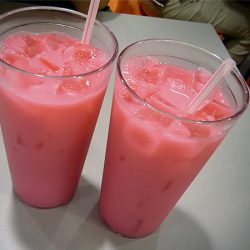
Sirap bandung (air bandung)
After all these delicious meals you’re probably looking for something sweet to drink. In Malaysia they have just the thing for you. Condensed milk with rose syrup on ice. This sweet and sugary drink is a local favourite called air bandung, also known as sirap bandung. This exotic milkshake pleases the visual senses with it’s bright pink color. If you enjoy sweet milkshakes then the rosy bandung is a must try.
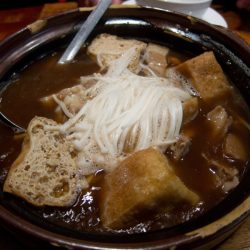
Bak kut teh
Bak kut teh is a nutritious dish that is often eaten in the morning and during lunch. It is a pork rib soup combined with a myriad of ingredients. The main ingredients of Bak kut teh include pork ribs in a broth or soup of mixed spices and herbs, with popular ingredients being cinnamon, garlic, star anise, cloves and fennel seeds. Often enriched with onions and shallots. But you will find variants alternative and vegetarian ingredients as well.
As it’s a soup it’s often served alongside other things. For the more hungry among us it can be served with bread sticks called You char kueh and soy sauce. And perhaps a nice refreshing cup of tea to match the soup.
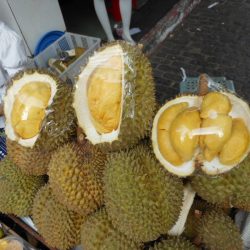
Durian
Durian is a unique, incredibly nutritious tropical fruit. In Southeast Asia it’s often considered one of the best fruits to have laying around. It’s sizable spiky shell contains custard-like flesh with large edible seeds. Compared to most fruits, it is very high in nutrients and vitamins, fiber and healthy fats. However it has intensive smell and taste and is filled with sugar. The flesh flavor resembles that of a mixture of almond, caramel and cheese and is used in both sweet and savory dishes.
Durian is often used as an ingredient of other dishes, but if you enjoy exotic fruits then you can also try this fruit by itself. It can be a bit of an acquired taste as the smell can scare some people away, but once you take a bite you will understand why it’s a local favorite, as it has quite a pleasant taste.
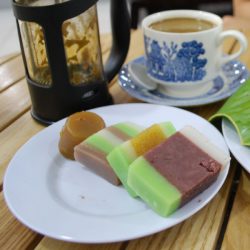
Kuih
Malaysians love to indulge themselves in sweetness. Kuih is a broad term referring to small Malaysian rice based pastries for people with a sweet tooth. These colourful and tasty snacks have a playful look to them, as if the cook had fun day off and spend his day creating all kinds of lovely treats for himself. Kuih comes in a wide range of flavours and textures, but coconut and pandan are undoubtedly very popular.
As many of these treats are steamed they tend to have a fairly distinct texture. These treats can be eaten at any time of the day, in between meals, as a fancy dessert or whenever someone comes to visit for a cup of coffee.
A personal favorite at Meet The Cities office is the Kuih Lapis, which is a delicious brightly coloured layered cake from rice flour, coconut and sugar. This is mostly eaten during festivities as it takes a while to make such a beautiful layered cake. Another delicious kuih is the Seri Muka, which is considered one of Malaysia’s cultural heritage foods. It has one half made from glutinous rice and one half made from a pandan flavoured custard, with coconut milk being used for it’s flavour and texture.
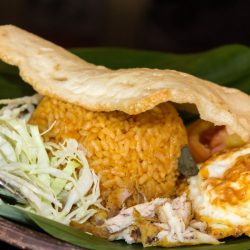
Nasi goreng kampung
Nasi goreng is one of the most popular dishes in the Malaysian and Indonesian cuisine. As you spend several days in Kuala Lumpur you will inevitably have to give it a try. The term actually covers a wide array of fried rice based dishes, including ones with prawns, chicken, eggs, onions, paprika, nutmeg, chilli and more. It’s often served in sweet soy sauce and with cucumbers and crispy krupuk. A popular variation is nasi goreng kampung, which is made with anchovies. This fulfilling warm meal can be eaten both for dinner and breakfast.
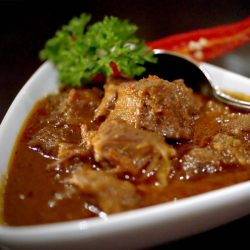
Beef Rendang
Beef Rendang is a traditional Indonesian dish, but it’s also an integral part of the Malay cuisine. And it certainly a must try for anyone traveling there. Traditionally, Rendang was a special dish used for honoring guests at ceremonies. Today you can find it at nearly every restaurant in Malaysia. For good reason because it’s quite delicious.
Rendang is a meat dish slowly cooked in a coconut curry mixture. It is spicy, delicious, and may be prepared using chicken or beef. There are variations that can contain seafood and vegetables as well. Rendang meat is intensely flavorful and stays moist due its preparation with coconut milk giving it it’s unique flavour. The outside is crisp and brown thanks to a special braising process. The large number of spices in rendang give it a complex flavor with notes of ginger, turmeric, and lemongrass. It is commonly served with various forms of rice.
Rendang is often considered one of the tastiests foods around, so if you haven’t tried rendang before then your stay in Kuala Lumpur will provide an excellent opportunity for you to give it a go.
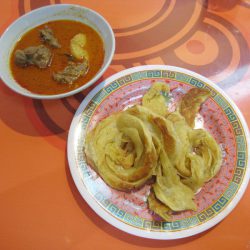
Roti canai
Malaysian people often eat Roti canai for breakfast. The dish has Indian origins but the Malay people have made it their own. For a good reason as it’s quite tasty. Roti canai is a flatbread that’s often eaten while dipping it in curry. As a flatbread it’s of course also possible to eat it with different fillings, such as banana, cheese, eggs, onions and even coconut jam. There are enough variations to make it a treat for everyone.
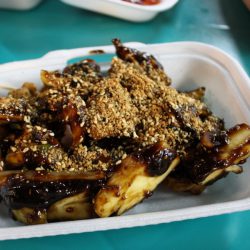
Rojak
Rojak is a fruit and vegetables salad often covered in a lovely sauce. As often seen in the rich Malaysian cuisine there are many variations, but the dish gets its distinctiveness from the sauce that contains a mix of sugar, lime, shrimp paste and chili ensuring the dish can have a sweet, sour and spicy taste. A popular variant also has peanut sprinkles. Fruit rojak is a dish that can be eaten as a snack or as a starter and usually has ingredients like cucumber, tofu, pineapple, bean sprouts and sometimes other ingredients like apples and mangos. Some variations can have egg, cuttlefish and more added into the mix. The fruity and spicy mix is not often seen in the western cuisines so it’s pretty interesting to taste. If you are wondering what to eat in Malaysia then you should try this local delicacy.
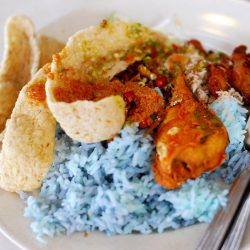
Nasi kerabu
Nasi kerabu is a visually appealing dish with Thai influence made using a distinctly blue rice, which derives its colour from butterfly peas petals. The blue rice is often served with fried chicken, fried fish, taugeh, eggs, kerupuk, sambal and is often eaten with a variety of aromatic herbs, which all goes nicely together. People often eat this dish with their hands, but that isn’t a requirement of course.
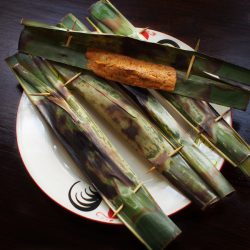
Otak-otak
Otak-otak is a fish cake which is traditionally grilled and wrapped into banana leaves. Delicious mackerel is used to make a boneless fish paste and mixed with a tapioca starch and spices made from garlic, coconut, onions, peppers, chili, curry powder and other ingredients. The mix is then char grilled in banana leaves to give it a warm earthy flavour. Traditionally the Indonesian version of the dish tends to be white. But in Malaysia the dish tends to have a more reddish or brownish color as it’s spiced with chili and curry powder as well.
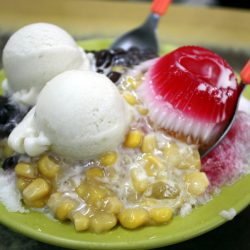
Ais Kacang
The Ais Kacang is mouth watering icy Malaysian dessert and an excellent dish to cool yourself down with during the warm Malay summers. It is generally known as Ice Kacang or Air Batu Campur. Made with the mixture of seeds, red beans, coconut milk, rose syrup and sarsaparilla syrup, the Ais Kacang dessert is a dish Malaysia can be proud of. It can be found pretty much at any place that sells ice as a dessert. You can find many variations, such as with freshly added roasted peanuts, durian flavoured ice cream and sweet corn topping which will leave you desiring for another one. Maybe finish it off with thin slices of banana to make the dessert truly shine.
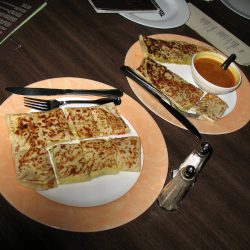
Murtabak
Murtabak is a folded pancake or a crispy stuffed flatbread which is filled with delicious ingredients. The unique flatbread often used in Malaysia is called Roti canai, which is popular for breakfast and usually eaten with curry. Murtabak contains minced beef or chicken meat, eggs, onions and garlic and is usually eaten with some form of curry. Of course many cooks also get creative with this dish leading to tasty variations. It can be found all over Malaysia so it’s if you wish to taste this peculiar meat pancake there is no excuse to skip it.
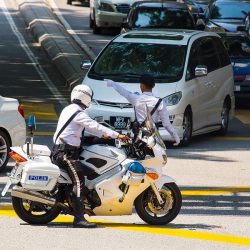
Police, fire brigade and ambulance in Malaysia
When you go to Kuala Lumpur, Malaysia you probably only think about all the fun things to do, but it is also wise to have some phone numbers in case an emergency takes place. So we made a list with the most important telephone numbers of the emergency services.
– The police as well as the ambulance in Kuala Lumpur have emergency phone number: 999 from a fixed line and 112 from a mobile phone.
– The fire brigade in Kuala Lumpur has phone number: 994 from a fixed line and 112 from a mobile phone.
– The tourist police in Kuala Lumpur has its own phone numbers which are: 03 2149 6590 for the hotline, 03 2149 6593 for enquiries and 03 8787 2312 for customs.
If you make a phone call to Malaysia from another country you will first need to dial the country code +60 followed by a city code. In the case of Kuala Lumpur you will first need to dial +603.
– The non-government organisation St. John Ambulance of Malaysia provides first aid and community services to the public and have phone number: (+603) 9285 1576
– The Malaysian Red Crescent’s Emergency Ambulance Service complements and supplements the government emergency medical services and can be reached at phone numbers: (+603) 2143 8122 and (+603) 2143 6122
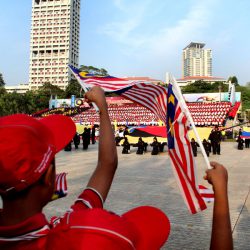
Holidays and festivities in Malaysia
Malaysia is a culturally rich country and so is the city of Kuala Lumpur. Many different ethnic groups like Malaysians, Chinese and Indians live together in this city. Most of them are Muslim, or Buddhist, but there are also large groups of Christians, Hindus, Taoists and Confucianists. The influence that all these groups have are reflected in the numerous different public holidays and festivities in Kuala Lumpur.
In 2024 the holidays are expected to be as followed:
1 January – New Year’s Day.
25 January – Thaipusam. It is a Hindu ceremony and a tribute to the Hindu god of war, Lord Muragan.
1 February – Federal Territory Day.
10 to 12 February – Chinese New Year, also called Spring Festival or Lunar New Year.
28 March – Nuzul Al-Quran. Muslim celebration of the revelation of the Quran to the Prophet.
10 to 11 April – Hari Raya Aidilfitri. Muslim holiday that celebrates the breaking of the fast.
1 May – Labour Day.
22 May – Wesak Day. Buddhist celebration of Buddha’s birth, enlightenment and death.
3 June – Agong’s Birthday. The birthday of the Malaysian king.
17 June – Hari Raya Haji. Muslim holiday, the feast of the sacrifice.
7 to 8 July – Awal Muharram. Islamic New Year
31 August – Merdeka day. National independence day
16 September – Malaysia day. Founding of the Malaysian Federation
16 September – Prophet’s birthday. Muslim holiday.
31 October – Deepavali. Hindu holiday also known as the festival of lights.
25 December – Christmas. Christian celebration of the birth of Jesus.
31 December – New Year’s Eve (not an official public holiday).

Opening hours in Kuala Lumpur
The opening hours in Kuala Lumpur depend on the area and the activity.
Shopping malls and shopping streets are generally opened: Mon-Sun 10.00 am – 10.00 pm.
While in some food street like Jalan Alor the opening hours seem to be 24 hours a day: Mon-Sun 24hrs.
Governmental organisations like libraries are opened: Mon-Fri: 8.00 am – 5.00 pm. Sat: 10.00 am – 7.00 pm. Sun: 10.00 am – 6.00 pm.
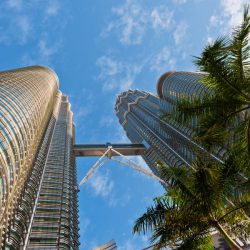
Weather and climate in Malaysia
The city of Kuala Lumpur has, like large parts of Malaysia, a tropical rainforest climate. This type of climate can be described as warm, sunny, with high air humidity and ample rainfall. This rainfall mainly takes place during the wet season, which is from October to March. This is also called the wet season. The dry season is from May to September, but also during the dry season you could expect over 10 days with rainfall. There are two monsoons during the year, which are the the Southwest Monsoon in the dry period from March to April, and the Northeast Monsoon in the wet period from October to November. In these two periods the rainfall switches from the mornings to the late afternoon. At times the rain will go on for an hour or so, but thereafter the rain is most of the times gone and replaced by the sun.
Although many visitors prefer the dry season, there is no real good reason why you shouldn’t visit Kuala Lumpur during the wet season. It is true that the fireflies in Kuala Selangor don’t like the rain, but on the other hand are the Hindu Batu Caves beautiful in the rain. And the city itself has a good infrastructure, is paved and has even covered walkways.
The temperature is pretty constant during the year averaging 27 degrees Celsius (81 degrees Fahrenheit) for the inland like Kuala Lumpur and mountain areas. The coastal areas have a more sunny climate with average temperatures about 30 degrees Celsius (86 degrees Fahrenheit).
So because of the temperature it is advised to wear lightweight and loose-fitting cotton clothing, but don’t forget to bring your umbrella. Remember that the Islam is the main religion in Malaysia and it is advised to avoid offending local sensibilities. At religious places men should take care that their legs are covered and women should cover their legs and upper arms.
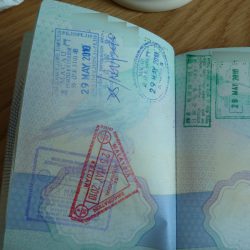
Passport and visa in Malaysia
The first thing that you should do is checking the validity date in your passport. Malaysian immigration authorities require that your passport is valid for at least six months after your departure date. If this isn’t the case they won’t permit you to get in the country.
The second thing that you have to check is if for your country a visa is required. If a visa is not required you need to check for how many days this isn’t required. Many visitors of Malaysia don’t need a visa when they visit Malaysia for a holiday or business. If your country is exempt for needing a visa you get a permit to stay in the country for a determined period. How long this period is depends on the country where you are coming from. For most exempted countries this period could be either 90 days, 30 days, or 14 days.
If you need a visa it is important that you get this in your home country before departure as Malaysia doesn’t offer visas to foreigners after they arrive.
A convenient site to check if you need a visa for Malaysia and how long it is valid is VisaHQ. Acquiring the right visa can be a hassle as there are different requirements for a tourist visa, a business visa and a work visa. This specialised company has the right knowledge and can arrange the required visa for you.
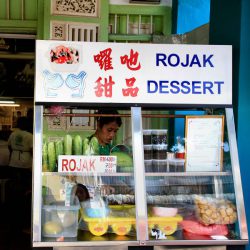
Language spoken in Malaysia
Malaysia is a country with many ethnic groups. The country has speakers of 130+ living languages, but the only official language of Malaysia is Malay although it is also referred as Malaysian or Bahasa Malaysia. Malay is dominantly and officially written in Rumi, which is a Latin script, but sometimes you will find places where people write Malay also in Jawi, which is an Arabic script.
Because Indians and Chinese are also large ethnic groups in the country, the government provides besides Malay, also Tamil and Mandarin at the primary schools. Another mandatory language of the primary and secondary schools, and even the main language of private schools and universities, is English. This means that English is widely spoken in Malaysia, especially in the big cities like Kuala Lumpur, George Town and Ipoh around the tourist attractions and in business. However, you have to bear in mind that the “Malaysian English” is a form of British English that is affected by the Malay, Tamil and Chinese language.
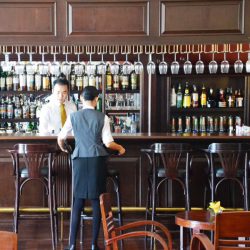
Tipping culture in Malaysia
In general you are not expected to tip in Malaysia as it isn’t normal practise in their culture. But if you have received an outstanding service, you are free to do so and it will be appreciated. There is no fixed amount or percentage that you should give when you do tip. You decide if you want to tip and how much that should be. But if you need some guidance, this is what you could consider.
In Malaysian restaurants it is normal practice that there is a 10% service charge added to the bill. Because of this service charge, which covers the tipping. As the tip can already be included in the bill there is no need for a tip. If a service is especially well received then some people do tip, then they wait for the change and give the coins as a tip for the waiter. If a service has been exceptional locals and tourists can decide to round up the bill.
In touristic areas waiter/waitress that serves you in a bar, club or similar establishments do commonly receive tips from travelers. It is not a requirement, but also not unusual to give a tip of about 10% of the bill. Of course their service needs to satisfy your expectations.
In Malaysian hotels is tipping not required. In their room price is often a service charge included. Although it is not expected it is well appreciated if you tip the housekeeper, room service, or bellboy. Depending on your budget and the service that you have received you can opt to tip between 2 and 5 Malaysian Ringgit per service. Sometimes tipping will help you to get you some extra attention from the hotel staff during your stay.
When you take a taxi you are not expected to tip the taxi driver. Especially if the taxi driver didn’t put on the meter, because chances are high that you already have paid too much for the ride. But if you really want to tip you are free to do so.
If you join a group tour guide a tip is not required, because that is probably included in the price. On the other hand you can tip the guide if it is a private tour guide and the price and service of the tour was good.
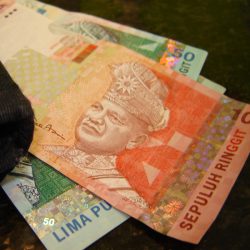
Paying in and the currency of Malaysia
The national currency of Malaysia is the Malaysian ringgit. Its international currency code MYR, and its official abbreviation is MR. One ringgit is divided in 100 cents (in Malay: 100 sen).
There are four different coins of which the values are: 5, 10, 20 and 50 sen. The banknotes come in six different values: RM1 (the blue note), RM5 (the green note), RM10 (the red note), RM20 (the orange note), RM50 (the blue/green note) and RM100 (the purple note).
Malaysia doesn’t have any restrictions for non-residents bringing foreign currencies in or out of the country. This is different regarding the Malaysian ringgit. Non-residents are allowed to bring up to the equivalent of 10.000 USD in ringgit in or out of the country. And yes this also includes traveller cheques. If you need to deviate from these restrictions you can ask for written permission from the Exchange Control Department.
It is possible to bring your home currency with you and change them after arrival in Malaysia for Malaysian ringgits. Especially at spots where many travellers come by you can find foreign exchange (FOREX) booths, money changers, travel exchanges or banks to change your local currency into Malaysian ringgits.
Another option is to withdraw the necessary ringgits in Malaysia. On the airports of arrival, at the tourist spots, banks and shopping malls you will find enough ATMs. We from Meet The Cities advise to change at least some of your home currency to ringgits before departing to Malaysia so that you have some ringgits in case an incident does occur on arrival. But it is absolutely not necessary to change your complete travel budget into ringgits as there are enough ATMs in Malaysia where you can withdraw money. It depends on your bank if there are any fees associated with withdrawal of money in Malaysia. Beware that having too much money on you could make you an attractive target for thieves.
Whether you use a debit or credit card. In case you’re from another region than South-east Asia it can be wise to inform your bank which period you are in Malaysia so that they don’t block your debit or credit card when they suddenly notice a transaction from a faraway region. Always take a phone number of your bank with you so that you can contact them in case there are any problems with your debit or credit card.
In case you want to make use of an international money transfer you have to provide at least the next details: the account number, the account holder, the name of the receiving bank, the IBAN number of the receiving bank and the SWIFT code. International money transfers will usually take five to seven workdays. A faster option, but possibly with a higher fee, is a transaction with Western Union.
The three largest and trustworthy banks in Malaysia are: Malayan Banking, Public Bank Berhad and CIMB.
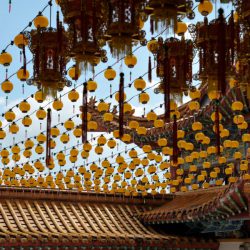
Culture and values in Malaysia
In Malaysia do live many ethnic and religious different cultures together. In order to understand the cultures, traditions and values of this country you first need to understand the geography of the country.
Malaysia is a country that is physically split in two areas: East Malaysia and West Malaysia. West Malaysia is in the south of the Malay peninsula where it borders with Thailand in the north and Singapore in the South. Most cities and immigrant groups in West Malaysia are located on the west coast. East Malaysia is on the north of Borneo where it borders with Indonesia and Brunei. Here do mainly live Malay people, but it is less wealthy and also has less than 30% of the total Malaysian population, so they tend to have less influence on the Malaysian culture and values than the people from West Malaysia.
Because of the immigration there are three main cultures in Malaysia, which are the Malay culture, the Chinese culture and the Indian culture. Smaller groups can have an Eurasian culture or several indigenous cultures from the Malay peninsula or Borneo. Other influences of Malaysia’s culture come from the Persian, Arabic and British culture.
In the 1971 National Culture Policy the Malaysian government provided some guidelines for what they considered as Malaysian culture:
– Malaysian culture is based on the cultures of indigenous people.
– Elements from other cultures that are judged suitable and reasonable may be considered Malaysian culture.
– Islam is an important part of Malaysian culture.
Currently the ethnic groups are approximately divided as follows: 50% Malay, 22% Chinese, 12% Indigenous, 7% Indian and 9% other. Of these ethnic groups are the Malay dominant in politics and the Chinese dominant in business.
Although Islam is the official religion in Malaysia, many world religions are present in Malaysia. The different religious groups are approximately divided as follows: 61% Sunni Islam, 20% Buddhist, 10% Christian, 6% Hindu and 3% other. These ethnic and religious groups are correlated with each other as most most Malays are Muslim, most Chinese are Buddhist and most Indians are Hindu, but each of these ethnic groups also have a Christian minority.
This mix of ethnic and religious groups makes Malaysia a very cosmopolitan place. The government makes a lot of effort to not privilege one group over another and to keep all of the groups satisfied, which is not always an easy task. This diversity has the advantage that Malaysians easily understand and connect with people from all over the world. And because of the existence of all these different groups in the Malaysian society, they easily accept some mistakes in etiquettes from outsiders.
An example of such an etiquette is that not every outsider knows that you should greet, receive, give and point only with your right hand, since the left hand is used for cleaning the body. A handshake with the right hand is considered standard between men, but some Malaysian people don’t shake the hand with people from the opposite gender. If you are a man, then you could wait for the woman to reach out her hand first. Malaysian culture is very hierarchical and saving face is very important. As a result is their way of communicating not always as direct and very polite. People in general, but especially persons with high ranks, expect to be treated with much respect. A simple example of respect is to use people’s title and surname when speaking to them. Use the first name (together with a Mr. or Mrs.) only when you are absolutely sure you’re allowed to do so. Another example of respect in business is to accept a business card with both hands and study it before putting it away. And if you do argue with a Malaysian person make sure it is in a private place and not in public in order to let the person save face.
A great side effect of this diversity is that there has arisen a delicious Malaysian cuisine which is partly divided by ethnic lines, but has also mixed foods with influences from Malay, Chinese, Indian, Sumatran, Javanese, and Thai cuisines. If you have dinner with a religious person make sure you have checked their dietary requirements. Different from western dinners is that food is served at once instead of in courses.
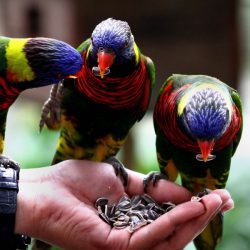
KL Bird Park
The Kuala Lumpur Bird Park is the largest covered bird park in the world where you can just walk in and see the birds live freely in their habitat. The park is almost 21 acres big and home to over 3000 birds of hundreds of species which gives an impression of the diversity the park has to offer. This is why the park often draws the attention of many bird spotters. The park aims to reproduce the natural environment of the birds to make it as comfortable as possible for the animals.
It’s lots of fun to stroll to the park and meet the animals up close. The park offers feeding moments and bird shows at set times. Especially the eagle feeding show is a nice display for every animal fan. Waterbirds like Flamingos and dozens of colourful oriental birds like Toucans and are also quite popular in the park.
The Kuala Lumpur Bird Park has a small entrance fee. At Meet The Cities we believe the bird park is certainly a recommended visit for families with children, as this is a great opportunity for children to see the many colourful birds up close. And the park offers many family photo moments for the visitors.
The bird park is located inside of the freely accessible Tun Abdul Razak Heritage Park, so a good way to reach it is by using the hop-on hop-off bus that goes from Merdeka Square through the park. Another way to reach this park is by taxi.

Aquaria KLCC
Aquaria KLCC is an extensive oceanium that houses thousands of aquatic animals. From colourful fish like lionfish, piranhas and seahorses to dangerous tiger sharks, stingrays and large turtles.
The Aquaria creates a nice atmosphere where you’ll feel immersed into the ocean, as you walk past and through huge aquariums of various shapes and sizes, sorted by themes that recreate their natural habitat. One of it’s most impressive attractions is the 300 feet or 90 meters long glass tunnel through a huge aquarium where you can see sea creatures swimming on all sides around you.
The feeding schedule of the animals is spread out over most of the day, so there are plenty of opportunities to see the feeding frenzy. Aquaria contributes to several animal conservation programs and you can see the animals here are well taken care of.
For the more adventurous travelers among us the oceanium also offers a diving experience where you can swim between several types of sharks. For the less experienced swimmer you can also get into an underwater cage to experience the sharks up close.
Aquaria KLCC can be found inside the Kuala Lumpur Convention Centre, which is located next to the Petronas Towers. So it’s easy to combine with a visit to the Petronas Towers. You can also combine it with a shopping trip to the neighbouring shopping mall Suria KLCC, where you can find signs pointing towards the oceanium. Aquaria KLCC can also be reached by taking the pedestrian bridge above the street from the shopping mall Pavilion KL to the KL Convention Center.
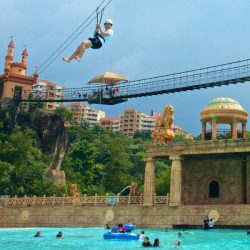
Sunway Lagoon attraction park
Sunway Lagoon is an award winning attraction park in Malaysia. Sunway Lagoon is one of the most exciting destinations on this list. It consists of an extensive water park, an amusement park, a Nickelodeon themed park, a wildlife park, an extreme activities park and more. Together these themed sub-parks form a diverse, wild and complete experience where there are always things to do and you can always find a fun attraction to get lost in.
It’s a good idea to bring your swimming gear because the water park has some great attractions, from the world’s largest water attraction and huge waterslides to the Waterplexx 5D cinema, which is a 3D movie experience where you can also expect to get wet, and watery playgrounds for children. It also has an unmatched artificial beach with a wave simulator which allows you to hone your surfing skills.
There is also a Nickelodeon themed area, which also has pretty cool water attractions. From water fountains for children and slides that you can experience on a rubber boat to scary water slides, with a trapdoor below your feet, which opens up and sends you into a vertical free-fall over a slide and into the water.
In the wildlife park you can find a large number of exotic animals like the elusive white tigers, black panthers and other animals like bears and porcupines. It’s a complete zoo that comes with animal shows and wildlife encounters. It’s the perfect place to have a stroll through after a long day of swimming.
The extreme park focusses on somewhat more extravagant sports such archery, paintball shooting, kayaking, but it also has a few paid activities such as bungee jumping. This park is meant for the people who seek more excitement and love physical and thrilling activities.
The amusement park contains the ever so familiar family friendly attractions that you have come to expect from theme parks, such as a roller coaster, a rubber boat that goes over the river rapids and a swinging pirate ship. For younger kids there are also carousels and slides and other activities where they can enjoy harmless amusement.
At the moment of writing the park also has a scream park, which offers a house of horrors experience to visitors. The four interactive walk-through shows are well thought out and truly give a distinct flavour to this amusement park. Of course you do have to take the shows with a grain of salt and just enjoy it for what it is.
The park is located on a 15 minute drive from Kuala Lumpur in the neighbouring village of Petaling Jaya, and right behind the distinctive Sunway Pyramid shopping mall. As the park is quite nearby the best way to reach it is by taking the taxi directly to the park. But it’s also possible to go to Kuala Lumpur Sentral railway station and then take the RapidKL bus to the park.
The tickets to this park offer admission to all the sub-parks, so you can enjoy the whole experience from the waterpark, to the zoo and the roller coasters. Visiting the Sunway Lagoon attraction park is a great way to get maximum enjoyment out of your vacation.
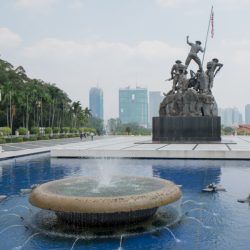
Kuala Lumpur Guided City Tour
The best way to immerse yourself in the local culture of a city and discover all landmark locations and hidden gems is with the help of a native tour guide who knows the ins and outs of the city. Getting a knowledgeable tour guide to show you around through the city of Kuala Lumpur, Malaysia, will ensure you get the most enjoyment out of your cultural journey.
Kuala Lumpur is known for it’s Petronas Towers, historical sites such as the National Monument, The National Mosque and colonial architecture around Independence Square but it’s also riddled with religious temples of all world religions. When you are familiarized with the history and culture of the city you truly start understanding how the city came to be and admire its grandeur in the right perspective.
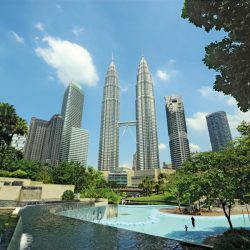
Petronas Towers skybridge
The Petronas Twin Towers are the most recognizable buildings of Kuala Lumpur. The skyline of the city is defined by these architectural highlights. The towers have a mind boggling height of 452 metres (1,483 ft) which makes it one of the largest buildings in the world. The twin towers are semi-detached, as 170 meters (558 ft) above the ground on the 41th floor you can find a huge skybridge connecting the two buildings. From this bridge you can oversee the entire city with a beautiful panoramic view that extends into the horizon. After visiting the skybridge you can take the experience another step further as you can go up to the dazzling 86th floor where an observation deck awaits the visitors.
Only a thousand visitors a day can get an entrance ticket to the towers, which is relatively few for such a huge tourist attraction. So if you get your ticket onsite it is advised to get them early in the morning. Visiting the most iconic building of the city is truly worth it.

Camp 5 Climbing Gym
If you’re feeling in a sportive mood then you’ll be happy to know that Malaysia has the largest indoor climbing gym in Asia. This gym called Camp 5 can be found on the fifth floor of the the beautiful shopping mall 1 Utama. Indoor climbing is a great way to release your energy and have fun doing it. It’s also fun for children to learn they can overcome obstacles like these. The 24 meters high facility has various walls with colourful handles suitable for all expertise levels. It’s also possible to follow a training course from professional instructors to get more familiar with climbing and to hone your climbing skills in a safe environment. One cool aspect of the Camp 5 facility is that the outer walls are huge glass windows, providing you with a beautiful 360 view of the city Petaling Jaya as you climb upwards.

Kuala Gandah Elephant Sanctuary
When you think of South East Asia then you think of elephants. You can meet these kind and majestic animals at the Kuala Gandah Elephant Sanctuary, also known as the Kuala Gandah Elephant Conservation Centre, which is the main elephant sanctuary in Malaysia. As the habitat of elephants is shrinking the sanctuary offers a safe home to displaced elephants, until they have found a suitable home in the wild for them again. Tourists are allowed into the sanctuary to fund elephant conservation programs and help raise awareness of the issues surrounding these endangered species.
The sanctuary offers an unique opportunity for a close encounter with these lovely creatures, feed baby elephants and watch (and sometimes even help) showering them in their habitat. Especially children love the close encounter with the animals. The elephant sanctuary is not located in the city center of Kuala Lumpur. To reach it you need to drive about 110 kilometers, which will take about 1,5 to 2 hours depending on the traffic. But it’s certainly worth the taking this small trip for.
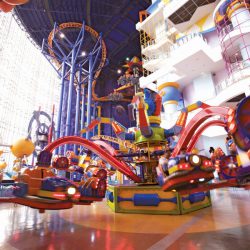
Berjaya Times Square Theme Park (Cosmo’s World)
One of the largest indoor theme park in Asia can be found in the shopping mall Berjaya Times Square. Most of the attractions in this park are rides aimed at kids of different ages. The theme park is divided into two interconnected sections.
On the fifth floor of the mall you will find the section of the theme park for which you have to be older than 13 years. This basically means you have to be taller than 140cm (4 feet and 7 inches) for some of the rides here. Here you can find a roller coaster that speeds through the sky and past the stores at 80 km/h. Other attractions you can find here are funfare-like attractions such as bumper cars and various spinning attractions.
On the seventh floor the attractions are intended for smaller children. On-rail trains, jeeps, a swinging boat and slower bumper cars and four other attractions. A total of 14 rides can be found in the theme park, which is enough to keep the kids occupied for half a day. If you are looking to spend some quality time with young children this is an excellent place to spend the day at.
The park is fairly easy to reach as it’s located in the most popular shopping area of Kuala Lumpur called Bukit Bintang. So regardless of your location in the city taking a taxi is a quick and cheap solution. On both sides of the theme park you can find bus stations, one is called Berjaya Times Square Jalan Imbi and the other Berjaya Times Square Jalan Pudu. The Imbi monorail station is also located right in front of the door. So there are plenty of ways to easily reach the shopping mall Berjaya Times Square, where the theme park is located in. And as Berjaya Times Square Theme Park is located indoors this family friendly attraction can even be enjoyed on a rainy day.
